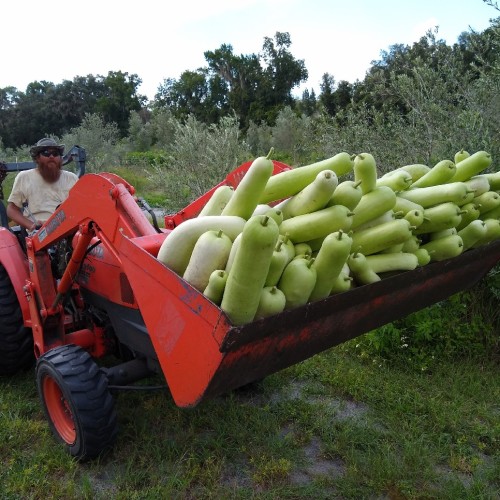
Here in Florida, the months of June through September offer an ideal testing ground for how well vegetables can tolerate hot, steamy weather. Many common vegetables struggle in the sauna-like conditions, but we’re finding that Lageneria siceria produces food here all summer like a champion.

They’re also good raw. If you harvest them young enough, the skin is soft and edible. Left on the vine a little longer, the skin starts to toughen, and I find that it’s best to peel them. Sliced into veggie sticks, they are an ideal low-calorie snack to keep on hand in the refrigerator when you get an urge to nibble. They’re great mixed into a salad, and I have used them all on their own (with dressing) to make a cucumber salad. You can also use Lagenaria fruits to make excellent “zoodles”, the raw zucchini noodles that have become popular as a low-calorie main course for the health conscious.

One local farm in my area grew a Lagenaria trellis 160 feet long in the summer of 2019. For four months, from June through September, this planting produced 250 to 400 pounds of fruits every week (production continued at a lower level as the days shortened and weather cooled in October). The plants kept growing and producing all summer while other cucurbit family vegetables nearby were destroyed by disease or pests – powdery mildew killed the summer squashes, and caterpillars (possibly pickle worms) devoured every leaf and fruit of Indian Dosakaya cucumbers.

Based on last years amazing production numbers, here are some estimates. Figuring conservatively, a 100 foot long trellis of Lagenaria, harvested while the skin is still tender, should be able to produce at least 100 pounds of fruits a week, probably more. Sold for a dollar a pound, that’s a hundred dollars a week, if the entire crop can be sold, which assumes that local shoppers and restaurants can be educated about using this vegetable. Labor costs of harvesting are low – maybe an hour of walking along the trellis with a cart or wheelbarrow during the weekly harvest, trimming off ripe fruits with a pair of pruners.

Great article and pics!
LikeLiked by 1 person
Thanks John!
LikeLike
Great information. Thank you. Curious where you got your seeds for the smaller variety?
LikeLiked by 1 person
Thanks. Source for smaller fruited variety ‘Dhol’ is seedsofindia.com
LikeLike
The young shoots are also an outstanding vegetable, aromatic and tender when cooked. I was quite surprised, I like them even more than squash shoots. And since there is plenty of pruning needed to keep them under control, there’s a plentiful supply throughout the season.
LikeLiked by 1 person
Great info! Thanks, Eric. I’ll try cooking some tips. I think one of the research papers I saw investigating anti-diabetic effects of Lagenaria included the shoots as well as fruits.
LikeLike
Great post with so much good info! I will definitely have to try growing this!
LikeLiked by 1 person
Thanks Melanie. Just be sure to look for a smaller fruited form like ‘Dhol’ from Seeds of India. The giant fruited ones are a little overwhelming, haha!
LikeLike
Correct to assume that deer would eat the plants?
LikeLiked by 1 person
I don’t know how these will do with deer – the planting I witnessed was in an area without deer. If deer do turn out to be a problem with Lagenaria, it would be fairly simple to set up an overhead trellis for the vines to climb, which also allow for easy overhead harvesting. It would only be necessary to put a small cage around each vine where it climbs from the ground to the trellis.
LikeLike
I want to grow this! Where do you find seeds? Thank you, great post!
LikeLiked by 1 person
Thanks! A number of varieties are for sale at seedsofindia.com
LikeLike
Woah, those are long! We grow those too, but not this long.
LikeLiked by 1 person
What part of the world are in? What do you call these in your area?
LikeLiked by 1 person
I am in California! We call it emugit in my language of Karamojong!
LikeLiked by 1 person